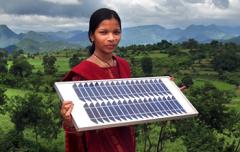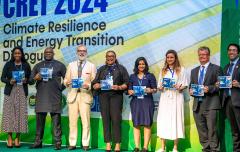Good project preparation maximizes financial viability/bankability
The differences between financing large scale energy infrastructure and small- or medium sized energy projects cannot be overstated. And yet, in many parts of the world, access to basic and modern energy services – including lighting and cooking – is provided specifically through smaller projects, and not through large scale energy infrastructure, which can take years to finance and develop. We know energy access is a critical component to development, including the ability to move out of poverty, and as of 2016, an estimated 1.1 billion people do not have access to electricity and more than 2.9 billion still rely on biomass for their cooking, leading to about 3.5 million deaths annually from indoor air pollution.
Despite the energy access gaps, strides have been made to develop and finance more types of projects that can help fill these energy access gaps. Total investments in clean energy have drastically increased over the past decade. In 2016 alone, solar generated PV and onshore wind brought on more than half of the new power capacity in the world in 2016, with global investments at $287 billion.
With increasing capacity factors and reduction in the cost of development, large wind and solar energy will also likely continuously to become cheaper in the long term. In fact, Bloomberg New Energy Finance estimates that by 2040, wind and solar will reach a 41% and 60% cost reduction respectively. Development and investment in small to medium scale distributed energy projects are also increasing, particularly at the electric service distribution levels. Navigant, an independent energy-consulting firm expects global investments for installed distributed energy capacity to reach a total of $1.9 trillion by 2024, and annual capacity to increase from 134.6 GW in 2015 to 530.7 GW in 2024.
Today, barriers still exist for investors seeking to develop and scale clean energy projects of all sizes in emerging markets. This is in part due to barriers that developers and other local entrepreneurs face when putting projects together. For international developers, barriers in emerging markets include uncertainties about local legal and regulatory environments, issues related to local currency financing project operations, and construction and technology risks. Local developers face similar barriers when trying to attract financing from national, regional and international sources due to currency mismatches that result from local currency operations, and hard currency financing obligations.
In addition, there are often limited options for funding development costs and capacity needs to help strengthen projects and businesses, critical components for growth and expansion and ultimately success in this sector. These challenges may be more acute for smaller and medium sized businesses in the energy access sector than in large scale energy infrastructure, although for any IPP or privately developed energy project uncertainties about the ways in which existing state-owned utilities interact with newly developed private (or public-private) investments are often concerns of international investors.
While there seems to be an abundance of financing seeking these types of investment, low familiarity with technologies and business models may compound nervousness around emerging market risks in general. On the demand side, there seem to be an oversupply of poorly structured projects, and in some cases a lack of commercial, financial and management skills to bring these projects to the stage where investors have enough confidence to invest. This creates a gap between projects seeking finance, and investors seeking viable projects, particularly in the small and medium sized project segment (see below diagram
In an effort to unpack the issues that result in this “gap” and to highlight the work of many who are trying to fill the “gap”, Sustainable Energy for All (SEforALL) and Power Africa recently co-hosted a webinar series to offer useful and actionable steps for project developers, advisors and other stakeholders. Featuring a panel of government and private businesses experts, this panel shared with others on how best to incorporate more robust project development strategies.
Here are a few key takeaways from this webinar, along with highlights from the experts who presented:
1. Multilateral donor-based clean energy financing vehicles exist to help advise businesses and countries on how to best prepare for projects. Both the Private Financing Advisory Networks’ (PFAN) Clean Energy Investment Accelerator, and the African-EU Renewable Energy Cooperation Program’s Finance Catalyst team are resources that help provide low-risk, low overhead networking models connecting small-and-medium scale businesses to private finance opportunities, and help provide necessary technical assistance to help entrepreneurs bring their concepts to “bankability”, attract financing at the right stages of development and help to “bridge the financing gap” for those small and medium sized projects.
2. Bi-lateral donor based entities, such as the United States Trade and Development Agency (USTDA) can provide directed support for project developers to overcoming these hurdles. Lida Fitts, the Regional Director for Sub-Saharan Africa at USTDA gave examples on how the agency helped provide private partners the necessary support in bringing infrastructure projects to financial close. For example, USTDA funds feasibility studies, and provides comprehensive analyses for major infrastructure investments to achieve financing and implementation. Additionally, USTDA also provides technical assistance to help create optimal legal and regulatory environments conducive in increasing project success.
3. Utilizing these support mechanisms, project developers should aim to ensure their project is “financially viable”. But also, on-the-ground practitioners encouraged investors to adjust their “appetites” according to different regions and contexts. Speaking from on-the-ground experience, Mayank Bhargava, CEO of NextGen Solar mentioned that project developers need to ensure “viability” of projects from end-to-end, including conducting feasibility studies, regulatory assessments, and acquiring licenses and agreements for electricity generation, among other preparation work, and that all these elements will improve the financial viability – and bankability – of any project. This work directly addresses investor’s risk concerns, and can help to increase their risk appetite when it comes to their financial, technological, regulatory/economic, and political concerns. Bhargava also urged for the need for financiers to understand that the local context is extremely important, and that developing projects can vary and be dramatically impacted by this context. Thus, investors need to remain flexible and open-minded when looking at these projects in emerging markets.
Download presentations
Project Preparation: Maximizing Financing Viability - NextGen Solar
Making Infrastructure Bankable Globally - U.S. Trade and Development Agency
Connecting Business with Finance in the Clean Energy & Climate Change Sectors - PFAN




